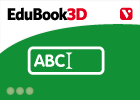Cargando...
Recursos educativos
-
Nivel educativo
-
Competencias
-
Tipología
-
Idioma
-
Tipo de medio
-
Tipo de actividad
-
Destinatarios
-
Tipo de audiencia
-
Creador
-

End-of-unit activities - The nervous system
EduBook Organización
- 3800 visitas
Right now, you are reading these words and you understand them. If you see food when you are hungry, your mouth starts to water. If you burn your hand, you move it away immediately. You automatically do…
-

Simple eggs and complex eggs
EduBook Organización
- 3792 visitas
All eggs protect and provide food for the zygote, and later the embryo. However, there are big differences in size and structure between simple eggs, like frog eggs, and complex eggs, like chicken eggs.…
-

Check what I know
EduBook Organización
- 3745 visitas
Copy and complete the sentences. Use the words below: green - deciduous - stem - leaves - roots - food - evergreen All plants have l, a s and r. F travels through the stem. Leaves are usually g in…
-

Introduction - The natural environment. Ecosystems
EduBook Organización
- 3719 visitas
Most of the energy used by living things originally comes from sunlight which is trapped by autotrophs (or producers). This energy is then transferred from the producers to all other living things…
-

Introduction - Jobs (II)
EduBook Organización
- 3696 visitas
People who work in the service industry, like teachers and nurses, help other people. Every day we buy food, clothes and other products. This activity of buying and selling is called trade. We buy…
-

Investigate - The natural environment. Ecosystems
EduBook Organización
- 3606 visitas
Most of the energy used by living things originally comes from sunlight which is trapped by autotrophs (or producers). This energy is then transferred from the producers to all other living things…
-

End-of-unit evaluation - The nervous system
EduBook Organización
- 3433 visitas
Right now, you are reading these words and you understand them. If you see food when you are hungry, your mouth starts to water. If you burn your hand, you move it away immediately. You automatically do…
-

End-of-unit activities - The natural environment. Ecosystems
EduBook Organización
- 3428 visitas
Most of the energy used by living things originally comes from sunlight which is trapped by autotrophs (or producers). This energy is then transferred from the producers to all other living things…
-

Talk about it. The natural environment
EduBook Organización
- 3412 visitas
Look at the picture and answer the questions. Look at the large photo. What sort of ecosystem does it show? Are the animals that live there herbivores or carnivores? Can they find food easily? What…
-

True/false. Plant nutrition
EduBook Organización
- 3390 visitas
Answer true of false: Plants do not need nutrients. Nutrition is all of the processes that living things use to convert the foods they ingest. Autotrophic organisms make their own food. There are three…
Te estamos redirigiendo a la ficha del libro...













